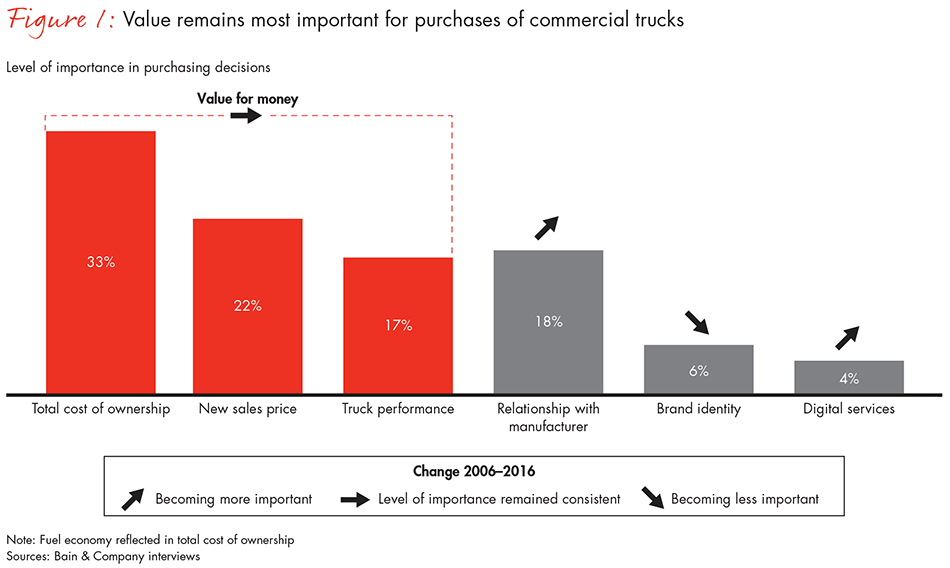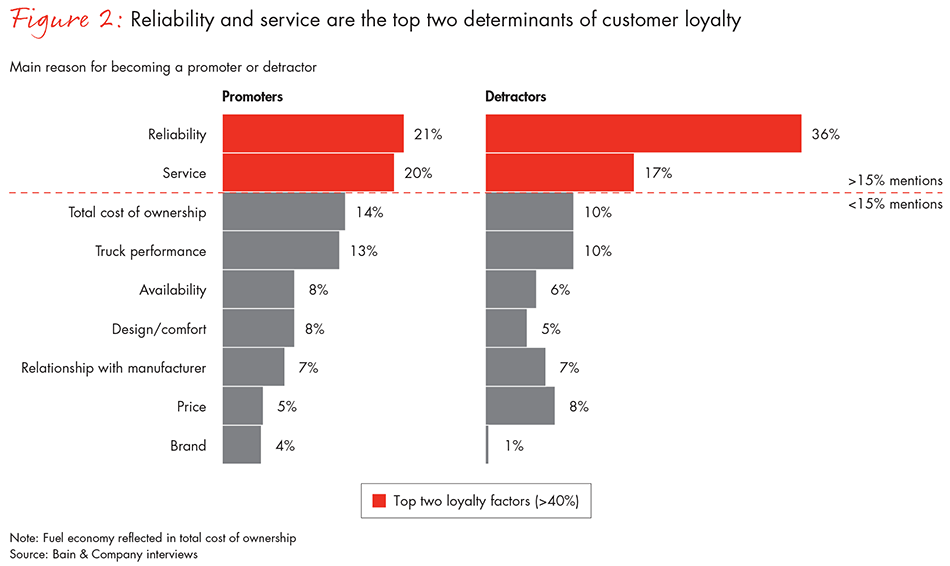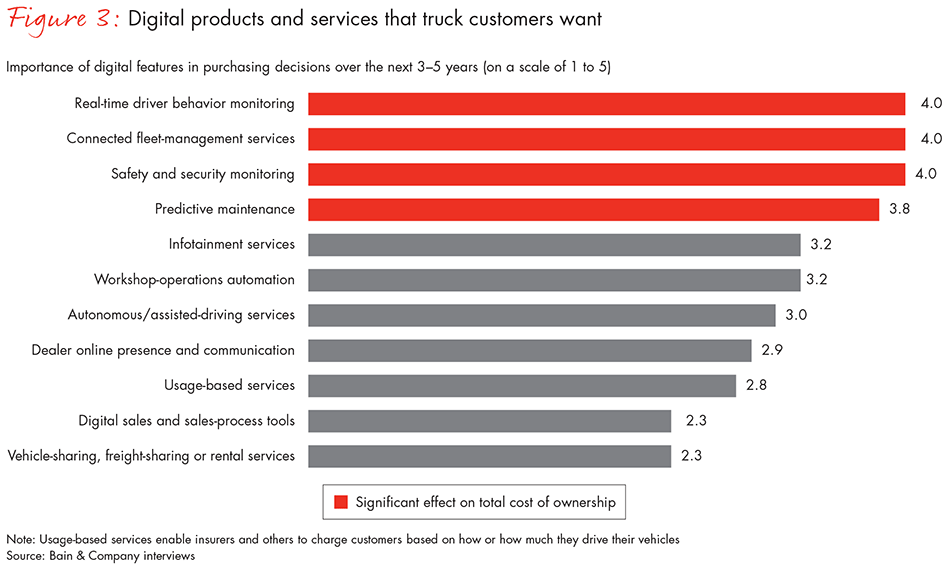Brief
 }
}
Even as the truck market becomes more global, Europe remains key to securing stable profits across economic cycles. Truck sales are growing rapidly in developing economies, but parts and services—which are essential to create sustainable profits—remain a small part of the market there. In Europe, sales of commercial trucks (greater than six tons) make up a significant portion of the global market in 2016 and are expected to grow 3%-5% annually over the next five years.
But the rules of the road for truck makers are changing. Europe's commercial truck market is characterized by significant competition and highly sophisticated customers, whose reliance on truck brand identity is fading. In the past, customers clearly associated top brands with better performance. But as truck makers have narrowed the gap between leaders and the rest, customers increasingly see performance as table stakes. These manufacturers must now differentiate themselves through their complete offer. This includes not only the vehicles, but also after-sales service agreements, customer relationships and especially services like those enabled by new digital technologies, such as improved fleet management and predictive maintenance. Success in Europe's truck market depends on a detailed understanding of the different segments and subsegments in the market, so that truck manufacturers can tailor offers better suited to their customers' specific needs.
To help European truck makers understand this core market better, Bain surveyed more than 600 truck customers from the 10 largest countries to gauge how well truck manufacturers meet customer needs, and where they excel or disappoint. This is the latest in a series of surveys we have conducted over the past 25 years. This year's survey focused on customer loyalty, key purchasing criteria and digital services across three dimensions: country, fleet size and truck application (for example, long haul or distribution).
Our survey generated three main insights.
- On average, the seven truck manufacturers1 in Europe are improving their abilities to meet customers' needs, and competition has become more intense. Overall, they increased their customer loyalty scores (which we measure using the Net Promoter System®; see below for details) from 14% in 2012 to 16% in 2016. Still, there's room for improvement: the gap between the best and worst manufacturers is high (39 percentage points), which also holds true for the gap between countries (25 points) and the gap across fleet size (7 points). The key to advancement is a better understanding of what increases customer loyalty within the different segments and across many customer touchpoints, and how to provide a digital offering that improves sales and loyalty.
- The customer's relationship with the original equipment manufacturer (OEM) and demand for digital services have both become more important as purchasing criteria. Although wide variations remain in sales price, customers consider the total cost of ownership over the life of the truck as the single most important criterion.
- Digital features are becoming an important differentiator, especially those services that can reduce costs or increase uptime for fleet owners and operators, and hence provide an immediate payoff.
What are the key truck-purchasing criteria?
We asked customers to rank their top criteria when buying a truck, allocating 100% according to their relative importance. The hard factors of ownership such as new sales price, fuel consumption and performance, which we called "value for money" in our survey, remain most important, reflecting the fact that a truck is an investment good (see Figure 1). Total cost of ownership (TCO) accounted for a full third of importance, followed by new sales price with 22% and truck performance with 17%. Brand, meanwhile, ranked relatively low.

OEMs can still differentiate themselves on the perception of new sales price, as indicated by the relatively wide differences among competitors in price as part of a bundled solution. Given that TCO remains the most important purchase criterion, even premium manufacturers with higher new sales prices can differentiate by demonstrating long-term value. We expect OEMs to increasingly bundle their offers in ways that provide a strong business case, focusing on TCO, uptime and a basket of features (including digital services), further diminishing the relevance of a truck's new sales price. What's more, the importance of TCO grows with fleet size, starting with 31% for fleets up to 10 trucks and rising to 39% for fleets larger than 50 trucks. In contrast, new sales price loses importance as fleets become larger.
Brand is becoming less important, sinking to a low of 6% in 2016, but it still plays a role in some purchasing decisions, especially for owner-operators. Customer relationships with the manufacturer, however, are becoming more important for purchase decisions and customer loyalty, particularly in such major markets as Germany, accounting for 18% of importance overall. Customer relationships improve with the quality and density of the dealer network, the service quality and offering (including digital services), and the quality and consistency of interactions at critical touchpoints.
What creates customer loyalty?
Overall, competition for loyal customers is intensifying. In this year's survey, the brand with the lowest Net Promoter Score® improved from -22% to -1%. Our survey also found that customers with larger fleets (more than 50 trucks) showed a lower average score (14%) than customers with fleets of 11 to 50 trucks (18%) or 10 and fewer (21%). Customers with larger fleets are typically more sophisticated and demanding because their purchasing departments are highly experienced in evaluating competitive offers. As a result, a deeper understanding for the individual needs of larger fleets provides upside potential. Net Promoter Scores for special applications of trucks (for example, construction or waste removal) are lower than average (11%), suggesting potential for improvement.
OEMs can tap that potential by improving reliability and service. Our survey found that truck reliability and quality of service, which will increasingly include digital services, were the top factors cited by both promoters and detractors (see Figure 2). Poor reliability was particularly likely to reduce customer loyalty. Our conversations with customers confirm that a breakdown is a critical moment: If the OEM's service network can prevent or resolve the problem quickly, professionally and courteously, it can improve customer loyalty and generate higher sales of parts and service contracts. Failure to resolve the issue efficiently, on the other hand, can decrease customer loyalty and create a detractor, diminishing the likelihood of future purchases.

What makes a successful digital service offering?
As digital services grow in importance, customers are already considering some OEMs out in front, with more than a third rating the digital services of two manufacturers better than the rest of the pack. We found a significant gap between these leaders and the OEMs ranked at the bottom, suggesting that several should act rapidly to develop and market attractive digital offers. They can expect prompt payoffs: Our study found every fourth customer willing to spend extra for digital services, with the large fleets leading the way.
The two major factors to achieve digital excellence are developing digital services that really matter and creating an integrated digital-service offer. Our survey found customers most interested in digital services that directly influence TCO and uptime, providing an attractive business case. These services include driver monitoring, fleet management, safety and security, and predictive maintenance (see Figure 3).

Customers also demand one-stop shopping from an OEM, and some manufacturers see the potential for digital offers that reach beyond their own brand to trucks from others. As they grow this part of their business, OEMs need to consider how to generate value from the large amounts of data collected through connected vehicles. This data offers valuable insights into truck usage across different environments and situations, and understanding what it tells them can help OEMs improve their designs and services, increasing sales and profits.
However, most truck makers face a real challenge in becoming digital champions. Digital requires new skills that differ from those that built the truck industry, including a shift of emphasis from hardware to software, and from products to solutions. Most OEMs will need to define a new digital operating model—including structure, governance and behaviors—to deliver on the digital opportunities that will be critical to success.
Growing share in Europe's truck market
Europe's truck manufacturers must continue to invest in customer loyalty in order to expand their market share. Based on our survey and conversations with buyers, four imperatives stand out.
- Understand customer needs. OEMs need a thorough and detailed understanding of customer needs to consistently deliver customer value. Established methods of customer analysis from other industries such as retail can help executives understand and manage the differences across segments.
- Master the table stakes. Manufacturers must deliver truck reliability, service, TCO and performance with consistently high standards. Failing to do so will quickly turn a customer into a detractor.
- Focus on customer relationship, after-sales and service delivery. Relationship and service remain key purchasing criteria for customers. Enhancing the customer experience through systematic investments will help OEMs improve sales of parts and service.
- Establish smart digital service offers. Focus on services that improve TCO and uptime to justify customers' investment and help them see better returns. OEMs will need to redefine their operating models to successfully deliver digital services, potentially unlocking significant new profits and even creating new lines of business.
Jörg Gnamm, a partner with Bain's Industrial Goods & Services practice, discusses the criteria of performance and quality, as well as the two platforms of differentiation that will help truck makers succeed in the future.
Net Promoter System
The Net Promoter System® is a powerful management concept that links customer feedback directly to the people in the company who can act on it to improve customer experience, products and services. The system's measuring tool is the Net Promoter Score®, which asks customers one question: "What is the likelihood that you would recommend this company to a friend or colleague? (Please rate from 0 to 10)." The answers are categorized into detractors, passives and promoters. The percentage of detractors is subtracted from the percentage of promoters to calculate the score.
Net Promoter System® and Net Promoter Score® are registered trademarks of Bain & Company, Inc., Fred Reichheld and Satmetrix Systems, Inc.
1 DAF, Iveco, MAN, Mercedes-Benz, Renault, Scania and Volvo
Jörg Gnamm is a partner with Bain & Company in Munich, and Johan Lundgren is a partner in Bain's Stockholm office. Both work with Bain's Industrial Goods & Services practice.
The authors would like to acknowledge the contributions of Sascha Seifert, a principal in Munich, and Martin Nilvall, a practice area director in Stockholm. Both work with Bain's Industrial Goods & Services practice.


